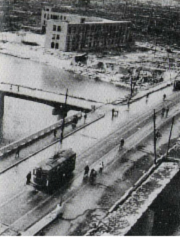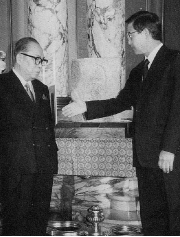


 |
|
| It was at 8:15 a.m. on August 6, 1945, in Hiroshima that an atomic bomb exploded over a populated target for the first time in the history of mankind, with 140,000 irreplaceable lives lost and the city reduced to ruins in an instant. The dreadful and cruel scene brought by the explosion was witnessed by the paving stones that had been laid under the streetcar tracks near Aioi Bridge, only 200 meters from the hypocenter of the bombing. | |
Aioi Bridge soon after the atomic bombing |
 |
|
Hoping to convince the world to renounce war through efforts to overcome various differences in race, religion, language and culture, a total of 10,000 people praying for global peace carved on the atomicbombed stones an image of the Goddess of Mercy, and the words “From Hiroshima.” It took them seven years to complete the task. The stones, an inheritance of our generation, were reborn as “Stones for Peace”, carrying a message of peace from Hiroshima. The stones assume the important role of conveying the significance of peace to future generations. |
|
People wishing world peace carved the image of “Kannon” (the Goddess of Mercy) on the atomicbombed stones |
 |
|
The Stone for Peace Association of Hiroshima was established in 1991 to distribute the stones to countries around the globe. The association hopes these potent symbols of the universal aspiration for peace will lead people in other countries to reflect on the importance of world peace. With the strong support of high-ranking officials of foreign countries, including many ambassadors in Tokyo and other eminent people from various fields who approve the purpose for which the association was formed, Stone for Peace have been sent to top leaders of various countries. |
|
The first stone was presented on August 6, 1991 - the 46th anniversary of the Hiroshima atomic bomb blast - to then President Fujimori of Peru. |
